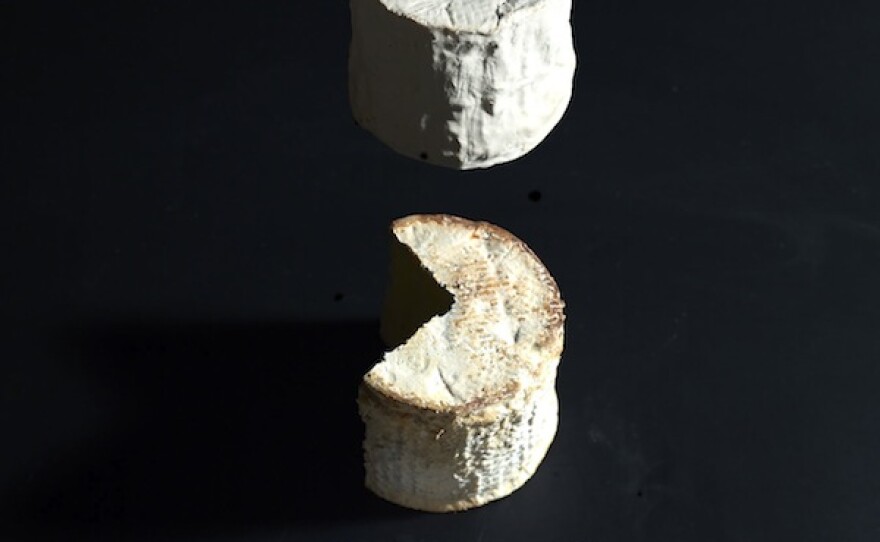Jacqueline Foster is the cheesemaker at Grey Barn Farm, an organic dairy in Chilmark. To speak about how she uses variations in moisture and salt to create the farm's three very different cheeses, she brought me to the large sterile kitchen where the cheese is made.
She described them for me, pointing out the differences. “Prufrock is our washed rind cheese - it’s a nice little eight-ounce stinker. Then about a year ago we started Eidolon, which is our bloomy rind; it’s sort of like a tall brie, or camembert. That one’s a nice big, one-pound cylinder. And then we just pulled out of our cave our first batch of blue, called blue bird.”
I eat a lot of cheese, but as I stood there in a pair of sterile white clogs and a clean white jacket, I realized I know very little about how and why the varieties I like are different. Jacqueline told me the process started in the 250-gallon stainless steel vat in front of us, when she curdles the milk using a set of enzymes called rennet.
“The amount of rennet and the time and the temperature allowed for the renneting process will determine how much moisture is locked in the coagulum, the gel of the cheese, and then from there the curd is cut,” she said. “And the size of the curd is going to determine how much moisture is inside. So for example, the Prufrock has a little bit of a shorter time of coagulation and the curds are cut sort of smaller than compared to the Eidolon.”
In other words, to get a slightly firmer stinky cheese like the Prufrock, you want a little less moisture. To get a softer, more camembert-style cheese like Eidolon, you want somewhat more.
From here the curds are stirred, drained, and put into molds, and it’s up to the cheesemaker whether they lose or keep moisture along the way.
“Moisture content will give you a different texture,” Jacqueline continued. “It will also help determine what types of molds, yeasts, and bacteria want to grow on that cheese. For example, with the Prufrock we’re trying to grow something called a brevibacterium linen - also known as b. linen - that orange bacteria that makes the cheese really stinky. That’s a moisture loving bacteria, but only to a certain extent. If the moisture level is too high, it can go really crazy, and you end up with something pretty weird. Each type of mold or bacteria or spore that you’re trying to grow has its certain happy place as far as moisture goes.”
The same is true for salt content.
“Certain molds, such as the white mold on the outside of the Eidleon or a camembert, don’t really like salt so much. That’s why those cheeses are typically less salty than others. But a cheese like a blue, like our bluebird, really loves salt. And that’s why you typically find really salty blue cheeses.”
It’s fascinating that such small variations in essentially two factors—moisture content and salt—make such a huge difference when it comes to the flavors and textures of the cheese. And this is why it’s so important that everything in the cheesemaking room is completely sterile and clean.
Jacqueline explained, “Oh, everything can go wrong. It’s a living organism, and our job is to try and control it - we want certain things to grow and certain things not to grow. We want to take something that changes constantly throughout the year and make it the same all year round. It’s challenging.”
Jacqueline was a chef, before she became a cheesemaker. Explaining how she got started, she told me, “I was looking for a change, and I was always very attracted to the transformation of something like milk into something so complex. There’s that magic that does happen in the vat all the time. But I think what really kept me here in cheese, was the technical side. I learn every day that I make cheese.”
Despite the fact that it’s made with only four ingredients—milk, rennet, salt, and cultures—cheesemakers estimate there are around 2000 different kinds of cheese made across the world. In addition to moisture and salt levels, geography also plays a big role in what kind of cheese a given place will make, because everywhere has its own unique set of living cultures.
The Local Food Report is edited by Jay Allison and produced by Atlantic Public Media in Woods Hole.










